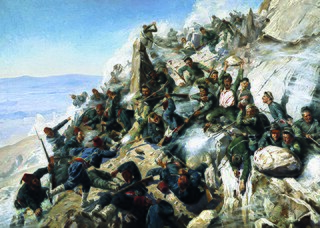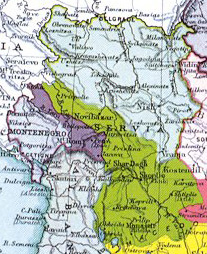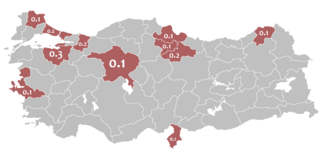This article includes information on the demographic history of Kosovo.

The Russo-Turkish War of 1877–1878 was a conflict between the Ottoman Empire and the Eastern Orthodox coalition led by the Russian Empire and composed of Bulgaria, Romania, Serbia, and Montenegro. Fought in the Balkans and in the Caucasus, it originated in emerging 19th-century Balkan nationalism. Additional factors included Russian goals of recovering territorial losses endured during the Crimean War of 1853–56, re-establishing itself in the Black Sea and supporting the political movement attempting to free Balkan nations from the Ottoman Empire.
The history of Kosovo is intertwined with the histories of its neighbouring regions. The name "Kosovo" is derived from the Serbian word "Kos". Black birds were full on Kosovo Plain, where the Battle of Kosovo was fought between Serbian states and the Ottoman Empire. Kosovo's modern history can be traced to the Ottoman Sanjak of Prizren, of which parts were organised into Kosovo Vilayet in 1877. In antiquity, Dardania covered the area, which formed part of the larger Roman province of Moesia in the 1st century AD. In the Middle Ages, the region became part of the Bulgarian Empire, the Byzantine Empire and the Serbian medieval states. It was then conquered by the Ottoman Empire, an exact 70 years after the Battle of Kosovo. In 1913 the Kosovo Vilayet was incorporated into the Kingdom of Serbia, which in 1918 formed Yugoslavia. Kosovo gained autonomy in 1963 under Josip Broz Tito's direction. Thios autonomy was significantly extended by Yugoslavia's 1974 Constitution, but was lost in 1990. In 1999 UNMIK stepped in.

The Kingdom of Serbia was a country located in the Balkans which was created when the ruler of the Principality of Serbia, Milan I was proclaimed king in 1882.
The rise of the Western notion of nationalism under the Ottoman Empire eventually caused the breakdown of the Ottoman millet concept. An understanding of the concept of the nationhood prevalent in the Ottoman Empire, which was different from the current one as it was centered on religion, was a key factor in the decline of the Ottoman Empire.

The Vilayet of Kosovo was a first-level administrative division (vilayet) of the Ottoman Empire in the Balkan Peninsula which included the current territory of Kosovo and the north-western part of the Republic of North Macedonia. The areas today comprising Sandžak (Raška) region of Serbia and Montenegro, although de jure under Ottoman control, were in fact under Austro- Hungarian occupation from 1878 until 1909, as provided under Article 25 of the Treaty of Berlin. Uskub (Skopje) functioned as the capital of the province and the mid way point between Istanbul and its European provinces. Uskub's population of 32,000 made it the largest city in the province, followed by Prizren, also numbering at 30,000.

Muhacir or Muhajir are the estimated 10 million Ottoman Muslim citizens, and their descendants born after the onset of the dissolution of the Ottoman Empire, who emigrated to Thrace and Anatolia from the late 18th century until the end of the 20th century, to escape ongoing ethnic cleansing and persecution in their homelands. Today, between a third and a quarter of Turkey's population of almost 80 million have ancestry from these Muhacirs.
Muhaxhir and Muhaxher are terms borrowed from Ottoman Turkish: muhacir and derived from Arabic muhajir. The term Muhaxhir(ë) refers to Ottoman Albanian communities that left their homes as refugees or were transferred, from Greece, Serbia and Montenegro to Albania, Kosovo and to a lesser extent North Macedonia during and following various wars.

The Vilayet of Manastir was a first-level administrative division (vilayet) of the Ottoman Empire, created in 1874, dissolved in 1877 and re-established in 1879. The vilayet was occupied during the First Balkan War in 1912 and divided between the Kingdom of Greece and the Kingdom of Serbia, with some parts later becoming part of the newly established Principality of Albania.

The 1923 population exchange between Greece and Turkey stemmed from the "Convention Concerning the Exchange of Greek and Turkish Populations" signed at Lausanne, Switzerland, on 30 January 1923, by the governments of Greece and Turkey. It involved at least 1.6 million people, most of whom were forcibly made refugees and de jure denaturalized from their homelands.
Albanisation is the spread of Albanian culture, people, and language, either by integration or assimilation. Diverse peoples were affected by Albanisation including peoples with different ethnic origins, such as Turks, Serbs, Croats, Circassians, Bosniaks, Greeks, Aromanians, Romani, Gorani, Macedonians from all the regions of the Balkans.
Justin A. McCarthy is an American demographer, professor of history at the University of Louisville, in Louisville, Kentucky. He holds an honorary doctorate from Boğaziçi University, Turkey, and is a board member of the Institute of Turkish Studies and the Center for Eurasian Studies (AVIM). His area of expertise is the history of the late Ottoman Empire.

In AD 1453, the city of Constantinople, the capital and last stronghold of the Byzantine Empire, fell to the Ottoman Empire. By this time Egypt had been under Muslim control for some seven centuries. Jerusalem had been conquered by the Umayyad Muslims in 638, won back by Rome in 1099 under the First Crusade and then reconquered by Saladin's forces during the siege of Jerusalem in 1187. Later in the sevenths Crusade, it was taken back by the Catholics once again. It was conquered by the Ottomans in 1517. Orthodoxy, however, was very strong in Russia which had recently acquired an autocephalous status; and thus Moscow called itself the Third Rome, as the cultural heir of Constantinople. Under Ottoman rule, the Greek Orthodox Church acquired power as an autonomous millet. The ecumenical patriarch was the religious and administrative ruler of the entire "Greek Orthodox nation", which encompassed all the Eastern Orthodox subjects of the Empire.

The colonization of Kosovo was a programme begun by the kingdoms of Montenegro and Serbia in the early twentieth century and later implemented by their successor state Yugoslavia at certain periods of time from the interwar era (1918–1941) until 1999. Over the course of the twentieth century, Kosovo experienced four major colonisation campaigns that aimed at altering the ethnic population balance in the region, to decrease the Albanian population and substitute them with Montenegrins and Serbs. Albanians formed the ethnic majority in the region after it became part of Yugoslavia in early 20th century.
Turco-Albanian is an ethnographic and religious term used by Greeks for Muslim Albanians from 1715 and thereafter. In a broader sense, the term included both Muslim Albanian and Turkish political and military elites of the Ottoman administration in the Balkans. The term is derived from an identification of Muslims with Ottomans and/or Turks, due to the Ottoman Empire's administrative millet system of classifying peoples according to religion, where the Muslim millet played the leading role. From the middle of the nineteenth century, the term Turk and from the late nineteenth century onwards, the derivative term Turco-Albanian has been used as a pejorative term, phrase and or expression for Muslim Albanian individuals and communities. The term has also been noted to be unclear, ideologically and sentimentally charged, and an imperialist and racialist expression. Albanians have expressed derision and disassociation toward the terms Turk and its derivative form Turco-Albanian regarding the usage of those terms in reference to them. It has been reported that at the end of the 20th century some Christian Albanians still used the term "Turk" to refer to Muslim Albanians.

Albanians in Turkey are ethnic Albanian citizens and denizens of Turkey. They consist of Albanians who arrived during the Ottoman period, Kosovar/Macedonian and Tosk Cham Albanians fleeing from Serbian and Greek persecution after the beginning of the Balkan Wars, alongside some Albanians from Montenegro and Albania proper. A 2008 report from the Turkish National Security Council (MGK) estimated that approximately 1.3 million people of Albanian ancestry live in Turkey, and more than 500,000 recognizing their ancestry, language and culture. There are other estimates however that place the number of people in Turkey with Albanian ancestry and or background upward to 5 million.
The events of persecution against the Serbian population occurred in Ottoman Kosovo in 1878, as a consequence of the Serbian–Ottoman War (1876–78). Incoming Albanian refugees to Kosovo who were expelled by the Serb army from the Sanjak of Niš were involved in revenge attacks and hostile to the local Serb population. Ottoman Albanian troops also participated in attacks, at the behest of Ottoman Sultan Abdul Hamid II.
The Expulsion of Albanians 1877–1878 refers to events of forced migration of Albanian populations from areas that became incorporated into the Principality of Serbia and Principality of Montenegro in 1878. These wars, alongside the larger Russo-Ottoman War (1877–78) ended in defeat and substantial territorial losses for the Ottoman Empire which was formalised at the Congress of Berlin. This expulsion was part of the wider persecution of Muslims in the Balkans during the geopolitical and territorial decline of the Ottoman Empire.

The 1914 Greek deportations was the forcible expulsion of around 150,000 to 300,000 Ottoman Greeks from Eastern Thrace and the Aegean coast of Anatolia by the Committee of Union and Progress that culminated in May and June 1914. The deportations almost caused war between Greece and the Ottoman Empire and were an important precursor to the Armenian genocide.















